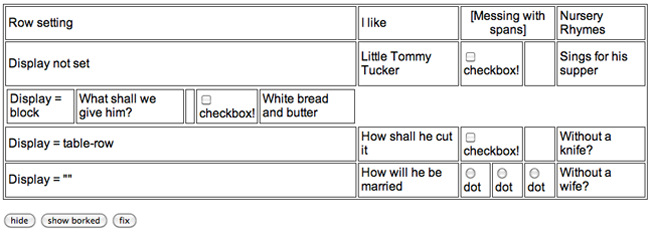How to check for specific variables passed from previous pages using Javascript for your prototypes
I use this technique when I’m prototyping a multi-step form/application and I know what data I want to show on the page depending on whether I’m walking through scenario A, B, or C. It’s good in situations where you’re setting radio buttons on the previous page and just need to know which one was clicked. It’s lousy for situations where you don’t know what value your previous page might’ve sent. It’s best used when your “Review” and “Confirmation” pages are virtually identical except for one or two key pieces of data. There, it saves you time from building 3 review pages and 3 confirmation pages.
It is extremely breakable and probably shouldn’t be used in production code.
This uses forms submitted via GET so all the variables are in the URL.
First, on the page with the form, make sure the value you want to pass is in an input element in the form with a name (and the value) assigned to it. Input type=hidden is handy for this.
Second, make sure you’re submitting the form on the first page. Yes, this sounds obvious but when you’re prototyping sometimes folks take the quick way out and just code a button with a location.href Javascript on it, and that’s not a form submission.
Third, make sure that when you submit the form, the variable you want shows up as a name/value pair in the URL of the next page. That means the value is getting to where you’re going.
Now for the fun part. On the page receiving the value you need to do two things:
- Get the method out of the URL
- Tell the page to use it to do something
To get the method out of the URL, we do this:
function getMethod(){
var thisurl = window.location.href;
var locationOfValue = thisurl.search('TheValueYouAreHuntingFor');
if (locationOfValue = -1){
//write yourself an error condition handler in case your value's not there
} else {
//do the thing you want to do if you found it
}
}
(Please excuse WordPress’s built-in CodeMangler for the spacing…sigh)
So what’s that do exactly?
window.location.href grabs the href (URL) of the current window in string format so you can search it.
String.search(regex) tells you the position where a regular expression occurs in a string. If it’s not present, String.search() returns -1. So we take our string (thisurl) and search it for the value of the name/value pair we’re sending, and assign the result to a variable (locationOfValue). (Yes, you can definitely use shorter variables. This is a sanitized version of a function I’m using elsewhere. And it’s more readable this way.)
If locationOfValue is equal to -1 we didn’t find it. Either your value wasn’t passed correctly or you came into the page directly and the first page didn’t get the opportunity to pass anything. This is a good place to put a “if there’s no value here’s what I want you to display” clause.
If locationOfValue is NOT equal to -1 we found the value somewhere in the URL. Do whatever it was you were planning to do when you got it.
Obviously, once you have the tools to grab the location and parse it for a value or three, you can build more complex if/else if/else statements, but this is the simple version.
Now the final challenge is getting your page to call your function. Because we want to read in from the URL and use its results to modify the page, we want to throw a script block on the bottom of the page that calls getMethod. Something like:
<script>
getMethod();
</script>
Write the page itself to be generic to whatever you want if it all crashes and burns spectacularly. (As they say on Mythbusters, failure is ALWAYS an option.) Then use the getMethod to read in your variables and modify your content accordingly.
I’ll try to build an example at some point soon.
*if you got the titular reference to the video game Catherine, w00t! Also, is that one creepy game or what?!



